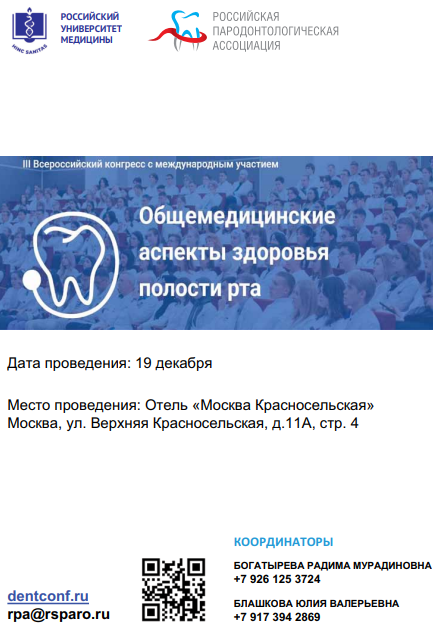Analysis of follow-up changes in incidence of oral diseases in Novosibirsk schoolchildren during the preventive treatment program
https://doi.org/10.33925/1683-3031-2021-21-2-103-109
Abstract
Relevance. The Russian Federation state program „Healthcare system development”, approved on April 15, 2014, relies on the introduction of the specialist „Dental Hygienist” in the system of school dentistry service as the main executor of the preventive treatment program. Government resolution #1640 as of 26.12.2017, which is to be realized during 2018-2025, included the agency project „“Primary prevention of oral diseases among the population of the Russian Federation”. The realization of the oral disease prevention project (professional cleaning, fluoride local application, permanent molar fissure sealing) is a basic program that includes necessary steps to reduce oral disease incidence rate and caries increase in schoolchildren. Administration of oral care products (fluoride varnish, sealants) immediately after tooth eruption, i.e., during formation and mineralization of the hard dental tissues, is more relevant, than the use of these products after the mineralization is complete. Aim – to assess the effectiveness of oral disease preventive measures by the analysis of the follow-up changes in the dental status of schoolchildren.
Materials and methods. 115 first-grade schoolchildren of two Novosibirsk general schools participated in the study. The schoolchildren were evenly divided into 2 groups: prevention and comparison. The parents and children of both groups were trained how to take care of the oral cavity at home. The children in both groups were examined, oral hygiene indices were determined and the teeth were treated. The preventive treatment in the first groups was administered with the following materials: fluoride varnish with innovative ingredient, tricalcium phosphate, and low fill fluoride-releasing light-cured sealant. The materials are certified and approved for use in children in the Russian Federation. The individual preventive treatment was not performed in the second group. The effectiveness of the preventive treatment was assessed by the analysis of follow-up changes in the dental status of the schoolchildren.
Results. The school preventive treatment program demonstrated a significant reduction of caries increase rate – up to 31.79% in the prevention group, which forms the basis for performance optimization of the school dental office where the priority belongs to a dental hygienist.
Conclusions. The results of the preventive treatment program with the participation of a pediatric dentist and a dental hygienist held in three Novosibirsk schools confirmed its high medical effectiveness.
About the Authors
T. I. ChebakovaRussian Federation
Novosibirsk
N. A. Zagetova
Russian Federation
Natalya A. Zagetova, Head of the 3rd Department of Treatment and Prevention
Novosibirsk
E. H. Volkova
Russian Federation
Elena Kh. Volkova, Head of the 1st Department of Treatment and Prevention
Novosibirsk
O. E. Ledovskikh
Russian Federation
Oksana E. Ledovskikh, Head of the 2nd Department of Treatment and Prevention
Novosibirsk
References
1. Avraamova OG. Improving the dental health of the Russian population as a result of the priority of prevention, medical examination and education of a healthy lifestyle. Crimean Journal of Internal Diseases. 2016; 3 (30):6-10. (In Russ.). Available from: https://www.elibrary.ru/item.asp?id=26536603.
2. Kisel'nikova LP, Gurevich KG, Nagoeva MM, Zueva TE. The impact of the dental prevention program on the quality of life of children aged 3-10 years. Stomatologiya dlya vsekh. 2011;4:52-55. (In Russ.). Available from: https://www.elibrary.ru/item.asp?id=17279862.
3. Kisel'nikova LP, Zueva TE., Boyarkina ES, Sokolova SI, Alibekova AA. Evaluation of the effectiveness of a preventive program for primary school children with the inclusion of regular use of chewing gum containing xylitol as an additional hygiene product. Pediatric dentistry and dental prophilaxis. 2014;13(1):3-6. (In Russ.). Available from: https://www.elibrary.ru/item.asp?id=21437700.
4. Kuz'mina EM, Yanushevich OO, Kuz'mina IN. Dental morbidity of the Russian population. Epidemiological dental examination of the population of Russia. Moscow. 2019. 302 p. (In Russ.).
5. Lapteva LI. The effectiveness of the implementation of a comprehensive program for the prevention of dental diseases among schoolchildren of the Central Administrative District of Moscow for 10 years. Pediatric dentistry and dental profilaxis. 2019;(76):37-43. (In Russ.). Available from: https://www.elibrary.ru/item.asp?id=11644844.
6. Leus PA, Manak TN, Makarova OV. Argumentation of the need for the relationship between dental and obstetricgynecological and pediatric services in the framework of the program for the prevention of dental diseases in children. Modern 2019;(76):37-43. (In Russ.). Available from: https://cyberleninka.ru/article/n/argumentatsiya-neobhodimosti-vzaimosvyazi-stomatologicheskoy-s-akusherskoginekologicheskoy-i-pediatricheskoy-sluzhbami-v-ramkah.
7. Olmsted JL, Rublee N, Kleber L, Zurkawski E. Independent analysis: efficacy of sealants used in a public health program. Journal of Dental Hygyene. 2015;89(2):86-90. Available from: https://pubmed.ncbi.nlm.nih.gov/25883369.
8. Kassebaum NJ, Bernabé E, Dahiya N., Bhandari B, Murray CJL, Marcenes W. Global burden of untreated caries: a systematic review and metaregression. Journal of Dental Research 2015;94(5):650-658. https://doi.org/10.1177/0022034515573272.
Review
For citations:
Chebakova T.I., Zagetova N.A., Volkova E.H., Ledovskikh O.E. Analysis of follow-up changes in incidence of oral diseases in Novosibirsk schoolchildren during the preventive treatment program. Pediatric dentistry and dental prophylaxis. 2021;21(2):103-109. (In Russ.) https://doi.org/10.33925/1683-3031-2021-21-2-103-109




































